It’s a Part of the Infrastructure (1:12):
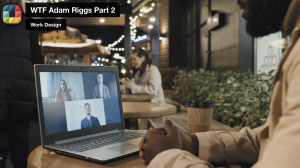 There are opportunities for software companies like us, and then there are opportunities for the end users, but the opportunities for the end users are sort of more like “we can’t consider distributed work a solved problem just because we have video conferencing software.” The leaders of the companies just have to continue to see this class of things as a priority that is a part of their infrastructure exactly the same way lighting and swiping access is a part of their infrastructure. This is a new class of infrastructure that directly contributes to their productivity and they cannot avoid it except at their peril. That’s what they need to do.
There are opportunities for software companies like us, and then there are opportunities for the end users, but the opportunities for the end users are sort of more like “we can’t consider distributed work a solved problem just because we have video conferencing software.” The leaders of the companies just have to continue to see this class of things as a priority that is a part of their infrastructure exactly the same way lighting and swiping access is a part of their infrastructure. This is a new class of infrastructure that directly contributes to their productivity and they cannot avoid it except at their peril. That’s what they need to do.
What the software world needs to do, myself, our company, Microsoft Zoom, WebEx, et cetera, is we need to invest in really invest in the end users experience and maybe not so much of a focus on admin tools. Admin tools are important, but most people are not admins. Most people have a job and they have resources and they’re trying to do their work. So if you really want to help people do better distributed work, you have to help them do their actual work.
No Second Class Participants (2:33):
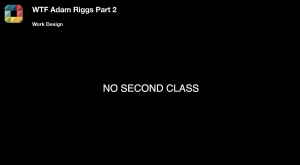 Say half the people are going to be remote and half the people are going to be in the office, how can we create an environment where the remote participants are not considered second class participants? They’re not considered any different and their contributions are not considered any differently. I think partially this is a tool question, but it’s also something that the leadership can establish as part of the culture of the company. Everybody who’s in that day knows that they benefit from being able to not be in the next day or the day before. If it’s a company with a hybrid policy and it’s two days a week out of the office, everyone who’s in the office today is going to be out very soon. I think that leaders can play a big role in normalizing the equity of the contributions to the discussion, no matter whether they’re coming from someone who’s in the room or not in the room.
Say half the people are going to be remote and half the people are going to be in the office, how can we create an environment where the remote participants are not considered second class participants? They’re not considered any different and their contributions are not considered any differently. I think partially this is a tool question, but it’s also something that the leadership can establish as part of the culture of the company. Everybody who’s in that day knows that they benefit from being able to not be in the next day or the day before. If it’s a company with a hybrid policy and it’s two days a week out of the office, everyone who’s in the office today is going to be out very soon. I think that leaders can play a big role in normalizing the equity of the contributions to the discussion, no matter whether they’re coming from someone who’s in the room or not in the room.
Managing the Physical & the Virtual (3:29):
 We set the tone that we’re not going to start the meeting when the people who are physically in the room are ready to start the meeting. We’re going to try to be deliberate about the invite list, and if someone on that invite list is remote, we’re going to give them all the respect and wait to start. I mean, as much as we can. If someone’s too late, they should send a note or give permission to start the meeting without them, whatever’s appropriate and reasonable. But the point is that there are things you can do to just acknowledge that we have two different scenarios here, physical presence and virtual presence, but we’re going to respectfully wait for everyone to come. We’re going to share notes. We’re going to share an agenda beforehand. We’re going to share notes after. One thing that’s great about Microsoft Teams is that the chat that you are using in the video meeting, it actually persists after the meeting and sometimes can be quite active and quite an important place for continued thinking on whatever the meeting was about. We just want to try and identify all of the ways that we can normalize people’s contributions, whether they happen to be in the room at the first moment, or whether they’re contributing virtually to the chat and sharing documents and whiteboards and things like that afterward. I think there are many ways where you can sort of signal that, and if the tools line up, then it’s a little bit easier.
We set the tone that we’re not going to start the meeting when the people who are physically in the room are ready to start the meeting. We’re going to try to be deliberate about the invite list, and if someone on that invite list is remote, we’re going to give them all the respect and wait to start. I mean, as much as we can. If someone’s too late, they should send a note or give permission to start the meeting without them, whatever’s appropriate and reasonable. But the point is that there are things you can do to just acknowledge that we have two different scenarios here, physical presence and virtual presence, but we’re going to respectfully wait for everyone to come. We’re going to share notes. We’re going to share an agenda beforehand. We’re going to share notes after. One thing that’s great about Microsoft Teams is that the chat that you are using in the video meeting, it actually persists after the meeting and sometimes can be quite active and quite an important place for continued thinking on whatever the meeting was about. We just want to try and identify all of the ways that we can normalize people’s contributions, whether they happen to be in the room at the first moment, or whether they’re contributing virtually to the chat and sharing documents and whiteboards and things like that afterward. I think there are many ways where you can sort of signal that, and if the tools line up, then it’s a little bit easier.
Design of the Virtual Experience (5:00):
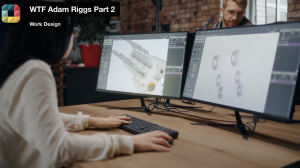 For a long time, I have firmly believed that the relationship between an architect and their client is a very special type of relationship because the client is trusting the architect and the interior designer to do something, which as we’ve talked about today, it’s hard to change the decisions that they have made quickly. There’s this tremendous, tremendous implicit level of trust in the judgment of the professionals to build an environment which is consistent with the way the client sees itself and the way it wants to be seen by the public, and it also is going to have to achieve certain things. The goal is always to create an inspiring, efficient, effective, accessible work environment where the company can bring its people and they can do their work either together or alone in whatever mix is appropriate for that business.
For a long time, I have firmly believed that the relationship between an architect and their client is a very special type of relationship because the client is trusting the architect and the interior designer to do something, which as we’ve talked about today, it’s hard to change the decisions that they have made quickly. There’s this tremendous, tremendous implicit level of trust in the judgment of the professionals to build an environment which is consistent with the way the client sees itself and the way it wants to be seen by the public, and it also is going to have to achieve certain things. The goal is always to create an inspiring, efficient, effective, accessible work environment where the company can bring its people and they can do their work either together or alone in whatever mix is appropriate for that business.
I think that 50 years ago it was a physical problem to solve. It was a design problem with physical solutions. You were placing skylights or not placing skylights, you were placing windows, you were placing walls, you were placing solid walls or glass walls, you’re picking carpet, you’re thinking about acoustics, but these are all things that are immediately physical or they have a physical component in the solution. Now, I think it’s very different.
I think there has been an increasing percentage of the contribution that is made by the non-physical components of the solution, and now that we have people really working in a distributed way, we have to think about the software environment, the software tools, and the things that they have on their desk. The things that the end users use every day and touch every day to do their actual work. And for me, I feel it’s clear that architects and interior designers who are being trusted to curate the physical space might have something to say about the tools that can curate or enhance the virtual space in a way that is consistent with the original mandate.
The goals of creating this beautiful, efficient, inspiring, flexible, accessible physical space, those goals can also be relevant to what is the software that people are using, and maybe it comes a certain way out of the box, but maybe there are ways that we can upgrade it or integrate it with something that brings that part of it a little bit closer to the bigger vision. It shouldn’t just be that when you open your computer or turn your computer on, you are dissociated from those goals or you are dissociated from the difficult thinking and the excellent work that the people that you hired to do it for the physical space have done. There are lessons there. The software choices can reflect that hard work and those lessons.
Software Should get the Same Care as the Office (8:14):
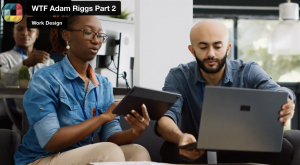 There is something similar about our challenges, which if everybody were just physically in exactly the same place, those challenges wouldn’t be there in the same way. So when a client hires an architect or hires an interior designer and says, our goal is a physical space that achieves all these standards and reflects us as a brand and reflects how we want to be seen in the world, there’s so much good thinking and hard problem solving that has to happen in order to achieve those standards. We should challenge ourselves to apply what we have learned and the things that we have realized in the journey to achieve that in the physical space. We should try to see how much of that is relevant to the software world because we have very high standards.
There is something similar about our challenges, which if everybody were just physically in exactly the same place, those challenges wouldn’t be there in the same way. So when a client hires an architect or hires an interior designer and says, our goal is a physical space that achieves all these standards and reflects us as a brand and reflects how we want to be seen in the world, there’s so much good thinking and hard problem solving that has to happen in order to achieve those standards. We should challenge ourselves to apply what we have learned and the things that we have realized in the journey to achieve that in the physical space. We should try to see how much of that is relevant to the software world because we have very high standards.
We don’t want to sit on an uncomfortable chair all day. I mean, that’s just the basic principle. People spend $800 on an Aeron chair. The point is that you use it every day, every minute of every day. Even if you have a standing desk, you’re still sitting in your chair sometimes so when you think about the category of things that you use every single day, you have to think about the software tools. You have to bring the same level of consideration to all of the things that you use that frequently. It doesn’t matter if it’s a physical chair or a piece of software.
There’s something good about applying that high standard to everything that you touch regularly in order to do your work. But the clients could use some reminder sometimes that that same care that they’re bringing to the design of their office can also be brought to expectations about the software that they’re using, and by elevating the standards that we’re seeking to meet, the software companies and the vendors that are providing these tools are going to internalize that they have to provide an excellent user experience.
Make the Work Environment More Successful (10:20):
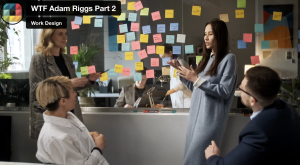 In order to judge the success of a distributed work model for a given company, there are just some basic things that the companies need to do. They need to, and I’m sure they are, a lot of them, measuring how long people stay before they even come on for the job. What percentage of the people are accepting our offers? What percentage of the people are we losing every year? What’s the average amount of tenure of an employee at our company? And regular surveys about how can we make working here more successful for you? The better your resources are, the better the work is that you’ll be able to do. We want to have an ongoing dialogue with you. You can do it through surveys, you can do it through town hall meetings. You should have people feeling like, first of all, what the company is asking of me is fair, what the company is providing me in order for me to do my part.
In order to judge the success of a distributed work model for a given company, there are just some basic things that the companies need to do. They need to, and I’m sure they are, a lot of them, measuring how long people stay before they even come on for the job. What percentage of the people are accepting our offers? What percentage of the people are we losing every year? What’s the average amount of tenure of an employee at our company? And regular surveys about how can we make working here more successful for you? The better your resources are, the better the work is that you’ll be able to do. We want to have an ongoing dialogue with you. You can do it through surveys, you can do it through town hall meetings. You should have people feeling like, first of all, what the company is asking of me is fair, what the company is providing me in order for me to do my part.
Those tools are the fair and appropriate set of tools and that there’s an ongoing opportunity for me to call attention to things that are not really working. I don’t think it has to be more complicated than that. No particular tool set, no particular set of resources is going to be good forever. It’s going to evolve just like everything else in the world evolves. It’s fair for me to expect what I expect. All of that can be great. It can be stable, and then in six months it can be wrong. So there has to be this ongoing dialogue. Without the ongoing dialogue, it’s difficult to have long-term success. With the ongoing dialogue, you can make an almost unlimited number of mistakes at any given point, but as long as you have the ongoing dialogue. The dialogue has to be there, and if the dialogue’s there, all problems are solvable.
Creating the Competitive Advantage (12:07):
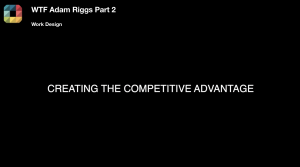 The labor market continues to be able to command a high degree of flexibility from employers. Employers are acknowledging that in order to compete for the best talent and retain it, they have to continue to allow this type of flexibility. I think what’s going to happen is the importance of distributed work overall is going to continue to hold and creep back up, and that the companies that are really leaning into it, they are actually able to create another competitive advantage for themselves.
The labor market continues to be able to command a high degree of flexibility from employers. Employers are acknowledging that in order to compete for the best talent and retain it, they have to continue to allow this type of flexibility. I think what’s going to happen is the importance of distributed work overall is going to continue to hold and creep back up, and that the companies that are really leaning into it, they are actually able to create another competitive advantage for themselves.
Now that people have proven that they don’t need to be in the office as much as they were in 2019, it now falls on the company and on the makers of the tools to evolve them in a way such that they can support distributed work very successfully because the demand for distributed work is not going to go down and the talent is basically saying, clearly we want some amount of this flexibility and to continue to evolve the tools at a fast pace and try things, and again, have this high degree of communication with the end users to try to figure out where’s the friction? where are the lines in the water that we can pull back in to help these teams that are not physically together do better work? And if you are a company that embraces that, at least the possibility of that, you’re going to get paid back over the long term.

